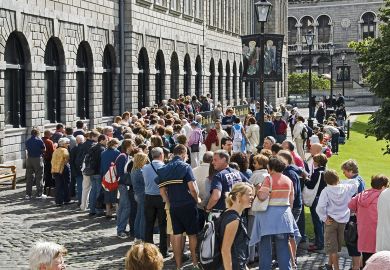Holding a UK general election during the university holidays appears to have dampened turnout in many seats where students live during term time, analysis suggests.
Labour’s landslide victory on 4 July was historic in bringing Sir Keir Starmer’s party back into power for the first time in 14 years on a record swing, but was also unusual in being held at a time when many students had returned to their home addresses.
The Higher Education Policy Institute (Hepi) had previously predicted that parliamentary constituencies where a large number of undergraduate seats live might see different trends in this general election compared with others in recent history.
Early analysis by Nick Hillman, Hepi’s director, shows a “very clear” pattern – that turnout fell compared with 2019 in all 20 of the parliamentary constituencies in England with the largest number of UK resident students.
Across these areas, turnout dropped by an average of 10 percentage points – compared with nationally, where it slipped from 67.3 per cent to 60 per cent.
“Clearly students are behaving differently to the national picture,” Mr Hillman told Times Higher Education. “That’s in line with what we predicted when we found out the election was not during normal term time.”
The results also suggested that the timing of the election had improved the efficiency of the Labour vote. Because students are more likely to vote for Labour than for any other party and many areas with universities had large Labour majorities even before the election, the presence of large number of students sometimes merely boosted the size of a Labour majority, Mr Hillman said.
While nationally the Labour vote share rose slightly, from about 32 per cent to about 34 per cent, in these top 20 student seats in England it fell by 11.5 per cent – including one constituency (Birmingham Ladywood) where it declined by more than 40 per cent.
“It shows that to a certain degree the Labour vote had sort of maximised itself in these seats in earlier elections because the students were around,” said Mr Hillman.
“Nonetheless, Labour continues to be completely dominant in student-heavy seats, holding nearly all of them, securing a large share of the vote and stacking up large majorities.”
In a few constituencies – Bristol Central and Leicester South – Labour lost not only vote share but also the seat. However, in others, such as York Central, Bath, the City of Durham and Newcastle Upon Tyne North, the party’s vote share rose from 2019.
Mr Hillman said the party would not be particularly worried because it can choose the timing of the next general election to its advantage, but the 18 Labour MPs in these 20 seats might feel differently.
“It will still be a bit of wake-up call for them, because when they get to parliament their vote shares have gone down while most of their fellow Labour MPs’ vote share has gone up.”
The results also showed a large swing towards the Green Party in the areas with the most students usually residing in them.
In comparison with the Greens, which had a lot in their manifesto aimed at universities, Mr Hillman said Labour had made fewer promises to the higher education sector.
“There’s not quite the same enthusiasm for Keir Starmer’s policies among students as perhaps there was for example, Jeremy Corbyn’s policies…whether he could afford it or not, he had a very clear offer for students.”




